Unstable Scraps, Part 1
The Unstable previews are done, which means it's time for some card-by-card design stories. As the cards in this set are extra unusual, that means some of the stories are, too. Sit back and enjoy the tales of some truly Unstable cards.
Animate Library
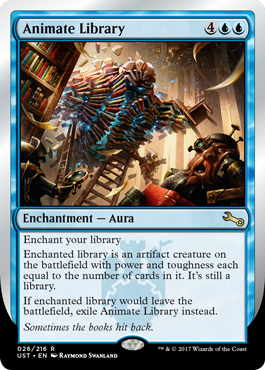
One of the best reservoirs for Un-card designs is black-border sets, because the lines between what's possible and what's not aren't always that clear. No matter how crazy a design is, I've learned to always start with black-border because I've been surprised in the past what we could actually do. Sometimes the idea works as-is, sometimes we can do it with a little tweak, and sometimes it inspires a completely different design that's doable. Often, though, I'm told it can't be done and then I put it in my "for the next Un- set" file (what I call the Un-Published).
Such is the case with Animate Library. I designed it many years ago. I don't remember for which set, but I assume it was back in the early days—Mirage, Tempest, or Urza's Saga blocks. My original version is basically the one printed in Unstable. It actually enchanted the library and turned it into a creature. The first problem was you can't actually put the library onto the battlefield. The library is itself a zone, and you can't put one zone into another zone. Once again, I'm talking black-border Magic. Silver-border Magic will stack zones like a Russian nesting doll, it doesn't care.
This led me to try a version where it was a */* creature where power and toughness were defined by the number of cards in your library. This version did work in the rules, but required a lot of counting. ("How big is it again?") This made other members of the design team nervous and led to a somewhat lengthy fight about the card. I thought it was splashy enough to warrant the extra attention, but I was in the minority, and the card was cut from the file.
Fast-forward many years later. Unstable was in development. I was doing a Sealed playtest—not for Unstable, but a normal set—and I was in trouble. In fact, I was about a turn away from losing and I was trying to figure out if there was any way I could survive the turn. I had some Aura in my hand, and I was trying to figure out if there was anything I could enchant that could save me. Realizing there wasn't a way out, I joked, "The only way for me to get out of this was if I could enchant my library."
I then had one of those moments where the past flashes by your eyes as you relive a series of events. I'd completely forgotten about Animate Library. It had been probably fifteen or more years since I'd made it and I hadn't thought about it since then, but the joke inadvertently reminded me. I remember calling out to Dave Humpherys, who was at the time the lead developer of the set (Dave, Billy Moreno, and Ben Hayes were each the lead developer for a while—Unstable was in development for years). I yelled, "Dave, I have a new card for Unstable!"
The card as printed is basically the original version I'd made, except we decided to have it make the library an artifact creature, as there are a lot of artifact synergies in Unstable and the flavor seemed cool. We did talk about adding a rider that would make you mill cards from your library (put the top cards into your graveyard) for each damage it took, but the card was already a bit wordy. We also talked about whether or not to have the last line, but losing the game the turn after your library got destroyed felt like a bit much, so we left it in. And that is how Animate Library, many years later, finally made it to print.
Baron Von Count
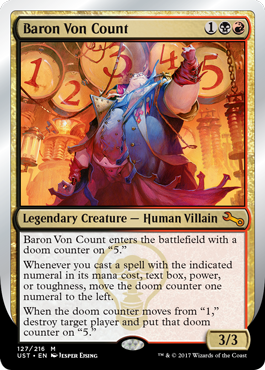
In Fifth Dawn, Aaron Forsythe and I made the card Door to Nothingness. To the best of my memory, here's the original design (with updated templating):
Killing Machine
5
CARDNAME enters the battlefield tapped.
WWUUBBRRGG, T: Destroy target creature or player.
We were tickled pink by this design. It just dripped with charm. Here, with dramatic license, is the conversation I had with then–Rules Manager Mark Gottlieb.
Gottlieb: That's charming. The card will never actually say that.
Me: Why not?
Gottlieb: Because we have a template for a player losing the game. It's "Target player loses the game."
Me: So what? We can have two templates.
Gottlieb: The game doesn't allow you to destroy a player.
Me: It could.
Gottlieb: For what reason?
Me: Because it's adorable.
Gottlieb: That's not a reason to make new templating for an ability we already have a template for.
Me: Players would get it. It wouldn't cause any confusion. Also, "Destroy target creature or target player loses the game" doesn't feel connected.
Gottlieb: Then we'll drop "destroy target creature." Why would anyone even choose that option when the other one is winning the game?
Me: It's not always about playability. Sometimes we should do things because it'll make players happy to see it. It's fun.
Gottlieb: Yeah, not going to happen.
The templating for Fifth Dawn happened late enough that I missed the window to get it into Unhinged. But I vowed that if we ever made another Un- set, I would include a card with "destroy target player."
Fast-forward many years to Unstable's design. We'd figured out the factions, and one of them was the supervillains (the League of Dastardly Doom). If anyone was going to "destroy target player," it was going to be them. One of the things I'd spent some time on was making sure that each organization worked differently from the others. I liked the idea that the League would be run by a cabal of supervillains, so I set out to make different archetypes.
One of them was the mad inventor intent on using his inventions to rule the world (think Lex Luthor or the majority of Bond villains). We liked the idea that he was making a doomsday machine, and that machine could kill players. We just needed a means by which he could do that. Meanwhile, we had a completely different design we were playing around with where players cared about the numbers on the cards you cast. It was similar to B-I-N-G-O from Unhinged, where you were trying to cover a variety of numbers up and the art would be a tool to help you mark things off.
One day, someone on the design team (Dan Emmond, Monty Ashley, Billy Moreno, Ian Duke, and myself—sadly, I don't remember whose idea it was) suggested that perhaps we could combine the two ideas by turning it into a countdown. The flavor of a doomsday machine with a countdown was perfect, so we changed it to caring about the numbers in descending order. So, only thirteen years later, "destroy target player" finally made it to print.
The Big Idea
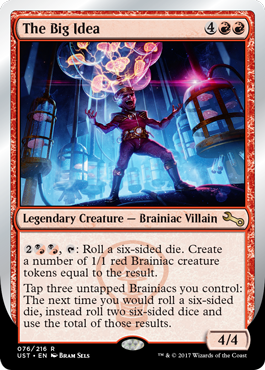
Each of the legendary creatures from the League of Dastardly Doom was originally inspired by a popular supervillain. Think you can guess what inspired The Big Idea? I will say it's drifted quite a bit, so it's tough.
The Brainiacs in the set were originally Clown Minions. They all tied into dice rolling because I liked the idea that clown villains are a bit chaotic. Instead of clowns, we designed a unique creature type for them. The Brainiacs were created during the worldbuilding. I liked that this card worked by itself but was sped up if you played it with its minions. I failed, by the way, in my quest to bring the Minion creature type back. (It has been discontinued in black-border sets.)
We did purposefully make the activation hybrid mana to allow The Big Idea to have a black-red color identity for Commander.
Blurry Beeble
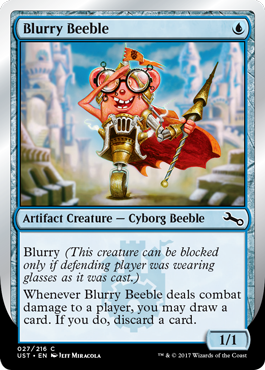
This card came about because of two things:
One, I wanted a Beeble in the set. Beebles were first drawn by Jeff Miracola for a cover of The Duelist. The assignment was to draw Squee. To add some fun, Jeff had Squee being "attacked" by a swarm of Beebles.

The players enjoyed the Beebles enough that we started putting them on cards in sets, mostly drawn by Jeff Miracola. At some point, it was decided that they were a little silly for normal Magic, and the Beebles got relegated to silver-border sets. As a fan of Beebles, I knew I had to make sure we got at least one in the set. (For more on Beeble history, you can read this article.) Beebles had been mechanically tied to unblockability, which led to the next goal.
Two, I wanted to have a card similar to Hurloon Wrangler from Unglued, but one that didn't encourage people to take off their pants.
There had to be some state that wasn't something people could just change. My solution? Beards. The original card was named something like Hairy Beeble, and it had Beardwalk, which meant it couldn't be blocked by someone who had a beard. I figured that wasn't something people could easily change. Would someone somewhere shave off their beard to block? Maybe, but hey, not often, and it would make a funny story.
Then one day, Elaine Chase (vice president of global brand strategy and marketing) played in a playtest. One of her notes was that beards were a bad thing to reference as for the most part only men could grow beards. I pointed out that having a beard was a negative thing, so it could only hurt you—meaning that not having a beard would never create a drawback in the game—but she made the strong note that it made women feel unwelcome, as it wasn't something they could interact with, even if it was only a negative thing. That was a really good point, one I was frustrated that I had missed, so I changed the card from caring about beards to caring about glasses.
This, by the way, is an important reason why you want lots of different people playtesting your product, because it's essential to get many vantage points. Things that aren't apparent to you can be very apparent to others, and it's key that you get that insight. I would much rather realize my mistake in playtesting than after the product has shipped.
Buzzing Whack-a-Doodle
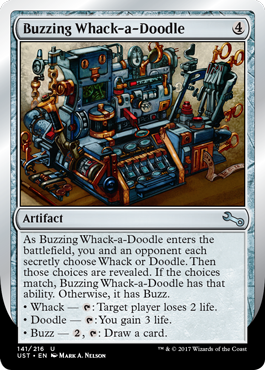
This card came about because the design team was fascinated by the idea of a card that revolved around a little mini-game when you played it. We knew that we wanted two things:
One, we wanted each player to make a choice when the card was played and have the combination of those choices dictate what the card did.
Two, we wanted to have a component where each player was trying to read the other. We loved the idea that there was a mind game going on.
The earliest version had three activations of varying power levels. You then secretly picked which one you wanted and your opponent picked one to block. If you and your opponent picked the same thing, the artifact was sacrificed. If not, you got the activation you chose. We liked the way it played, but the sacrifice seemed a bit harsh.
We then wondered if there was a way that each of you could make a choice that resulted in one of three outcomes. It turns out there is. We have you pick between the first two choices. If they match, that's the ability you get, but if they don't match, you get the third ability. To make the game work best, the three abilities needed to be of different power levels, with the third ability being the strongest. This way, the mini-game was for the caster to try and pick a different answer than their opponent while the opponent was trying to match.
We spent a long time picking the abilities because we wanted them all to be relevant. This added another element to the game. If either of the first two choices is better for you in the current game state, maybe you're more likely to pick that just in case that's the one you end up with. We actually came up with the third ability first—drawing a card. That was uniformly useful and served as a great incentive.
For the first two abilities, we were looking for things that were short (the card was already wordy) and different from each other. We liked the idea that one was more aggressive and one was more defensive. In the end, we chose to do personal life gain and opponent life loss. Getting the right numbers took some playtesting, but I'm very happy with where we ended up. I hope you all have as much fun playing this card as we had making it.
capital offense
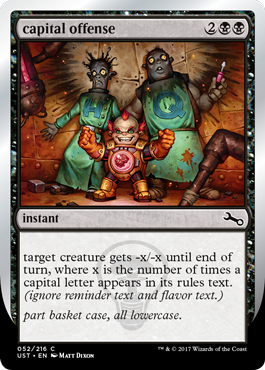
One of the things that's a bit different about Un-set card design is that the whole package matters. You usually aren't just making a single component, but trying to get a cohesive whole. Yes, this is somewhat true about black-border Magic, but not as strongly as it is in silver-border. As such, it's very common in design to create a name for a card that's key to the identity of the card. In fact, one of the passes I had to do before naming started was a "we really want this name" pass.
I bring this up because this card's design name was capital punishment (I believe it was always lowercase). It's a card that punishes having capital letters. The name and effect sprang into existence as a combined pair. There was no other name for this card. That is, until Conspiracy: Take the Crown was published with a card called Capital Punishment. (We did actually have a talk about whether one name with capital letters and one name without capital letters technically counted as the same name.)
I thought about taking the card out of the file, but Kelly Digges (who did the flavor text) convinced me that we should look at what other options we had. So I did a Google search for expressions with "capital" and was surprised to find numerous options. Capital offense seemed like the best choice, so I sent the suggestion to Kelly. The card is a lot of fun to play, so I'm glad we found another solution.
The Countdown Is at One
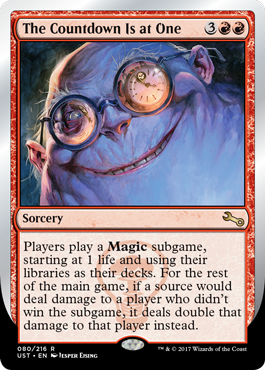
There are a number of categories of things that black-border sets can't do that I've tried to do in every Un- set. One of those is subgames. Richard Garfield made a card called Shahrazad back in Arabian Nights, the first expansion, that forced players to stop playing their current game and start playing a different game. Then the winner of the subgame got an advantage in the main game. (Richard claims, by the way, that Shahrazad is his favorite personal Magic card design of all time—it's particularly flavorful if you know the bridging story of One Thousand and One Nights.)
Shahrazad caused all sorts of problems in tournaments (mostly making games run long)—so much so that it got banned. R&D then made a rule that we could no longer do subgames in black-border sets. So, when I was making Unglued, I realized this was an area I could play around in. I ended up making Once More with Feeling, which made you play a subgame that essentially won you the game. I'm not sure it technically counts as a subgame, as you never go back, but it was very much influenced by Shahrazad.
Then in Unhinged I wanted to make a more proper subgame. To keep it from going long, I started players at 5 life. Also, for some fun flavor, we made the players play the subgame under the table. For Unstable, we wanted another subgame, but we decided to speed things up even more, changing the starting life from Enter the Dungeon's 5 life to just 1 life. We put the ability in red because we felt this was the color that could best capitalize on quickly winning this subgame. Tying the flavor to Baron Von Count and his doomsday machine was a brilliant idea by Kelly.
Cramped Bunker
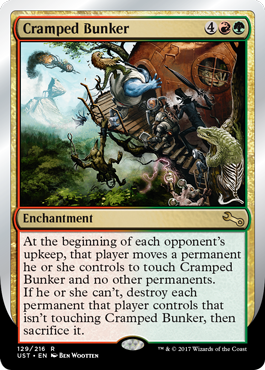
This card was designed by Richard Garfield. But wait, Richard wasn't on the design team for Unstable. No, he wasn't. He was, however, on the design team for Dominaria, which is where he turned in this card. I remember reading it in a meeting and saying, "I'm pretty sure we can't put this here, Richard, but I think I have a home for it."
Crow Storm
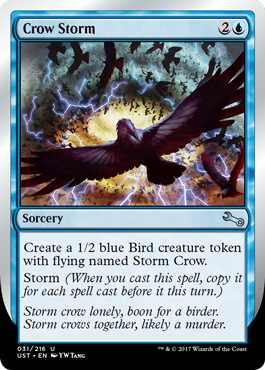
How many of you expected a storm card in Unstable? I'm guessing not many. This card came about because multiple different designers on the team submitted it. It's been a running joke forever, and where better to make running jokes come to life than in an Un- set? The interesting question about this card is, why is this in a silver-border set? Couldn't we have done this in a black-border set?
The answer is not really. As the Storm Scale strongly reminds us, we're very unlikely to put storm into a Standard-legal set. It's even problematic in non-Standard-legal sets because storm is such a powerful ability, and as silly as making Storm Crows sounds, it's a viable win condition. When we first put Crow Storm in the set, I went and talked to the then-developers (who would now be called play designers) to see if this was a card we'd ever want to make in black-border. The answer was that if we did it we'd have to be super conservative and we'd probably make a card that just looked horrible to players.
In Unstable, we could be more aggressive and deliver the card in the form players actually wanted. Also, putting it in a silver border allowed us to have fun with it and maximize its creative pop.
Unstable Setting
That's all the time we have for today. I hope you've enjoyed all the stories. As always, I'm eager to hear your feedback both on Unstable and on today's column. You can write me an email or talk to me through any of my social media accounts (Twitter, Tumblr, Google+, and Instagram).
Join me next week as I continue to tell Unstable card-by-card stories.
Until then, may you have a lot of fun with Unstable.
#490: Unstable, Part 3
#490: Unstable, Part 3
41:19
This podcast is the third and final part of the story of Unstable's design.
#491: Being Spokesperson
#491: Being Spokesperson
31:51
Besides designing Magic cards, I also spend a lot of time interacting with the public. This podcast talks all about this aspect of my job, including how I came to be a spokesperson.
- Episode 489 Unstable, Part 2 (28.1 MB)
- Episode 488 Unstable, Part 1 (24.2 MB)
- Episode 487 Pitching (23.0 MB)

